How to Determine Knee High Compressions Sock Size for Men
Last Updated December 31, 2021
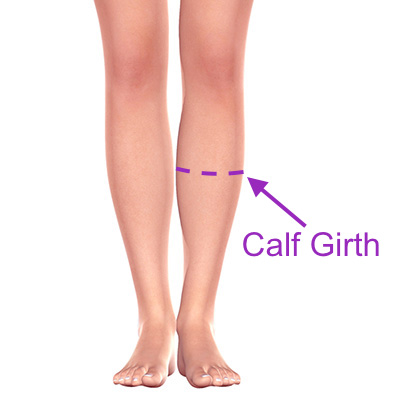
Looking to Buy a Pair of properly-sized Compression Socks?
Click the button below to see the lineup of ComproGear Compression Socks.
NOTE: The page includes a sizing chart and free returns, so you're always sure to get the perfect size!
After reading extensively about compression socks, your next step is actually shopping for a pair of compression hosiery, stockings, or other compression gear. But how easy is this? Unfortunately, it can be quite difficult because choosing the right compression sock sizes requires proper knowledge.
Finding a guide, or deciding the proper way to size compression socks, is no easy feat. This is because there are different brands, different leg sizes, and many other factors. To clear up any confusion and to ensure a smooth process deciding the compression sock sizes to choose, I've written this guide for you.
There are several subheadings in this guide that will help you understand compression stockings sizes. We'll begin from the level of compression you are required to wear, and this knowledge will help us identify the compression sock sizes that you need. I'll also cover compression measuring guides, why measurement is important, who should measure, what complications come from the use of compression stockings, and when to consult your doctor.
What Level of Compression Socks is Needed?
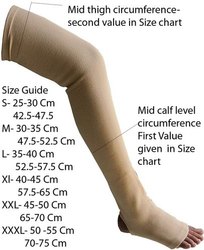
Measurement of graduated compression socks are done in mmHg (millimeters of mercury), and there are five different levels of compression.
A lower number signifies less compression, while higher numbers indicate increased compression.
Here's a breakdown of what you need to know:
Compression Level: 8-15mmHg (Mild Compression)
- This is the lowest level of compression.
- It may relieve or reduce the soreness in aching and tired legs.
- It could be useful for minimizing swelling in legs, feet, and ankles.
- It could be efficient for short trips, mild relief, and desk or stationary workers.
Compression Level: 15-20mmHg (Moderate Compression)
- Offers a mild level of compression.
- This is one of the most common compression levels used.
- It might be recommended for those who need relief from swollen ankles and legs during pregnancy.
- It is potentially vital for minimizing the risk of DVT (Deep Vein Thrombosis).
- It could offer relief and limit the pain that comes from spider veins and varicose veins.
- It's recommended for people who sit or stand for an extended period, offering smooth blood circulation in the legs.
Compression Level: 20-30mmHg (Firm Compression)
- Offers a firm level of compression.
- This is one of the most common compression levels used.
- It can relieve moderate to severe pain from spider veins and varicose veins.
- It is usually prescribed for people with abnormal swelling and edema.
- It can minimize or prevent the risk of deep vein thrombosis in a long haul flight.
- It can minimize the immediate drop in blood pressure in the leg that stems from prolonged inactivity and standing.
- May be recommended for post-surgery patients.
Compression Level: 30-40mmHg (Extra Firm Compression)
- Offers an extra firm compression.
- It is usually used when under strict medical supervision.
- It assists in relieving edema, lymphedema, and severe spider veins and varicose veins.
- It could provide relief from acute venous insufficiency
- It could also be suggested by a doctor to ease thrombosis or post-thrombotic syndrome.
- It can be used by post-surgery patients as well.
Compression Level: 40-50mmHg (Extreme Compression)
- The highest level of compression.
- Recommended by a doctor to patients with severe venous insufficiencies.
- Individuals with this condition are bedridden patients and lack consistent mobility of their legs.
- It can be used for post-surgery patients.
Now that we've identified the varying levels of compression and the prescriptions, what's next is determining the size of compression socks that you should purchase.
What Compression Sock Sizes Should You Purchase?
In order to determine this, you need to do two essential things:
Measure your leg: When measuring your leg, there are several questions to consider, such as the following:
- Who should measure?
- How should it be measured?
- What time should it be done?
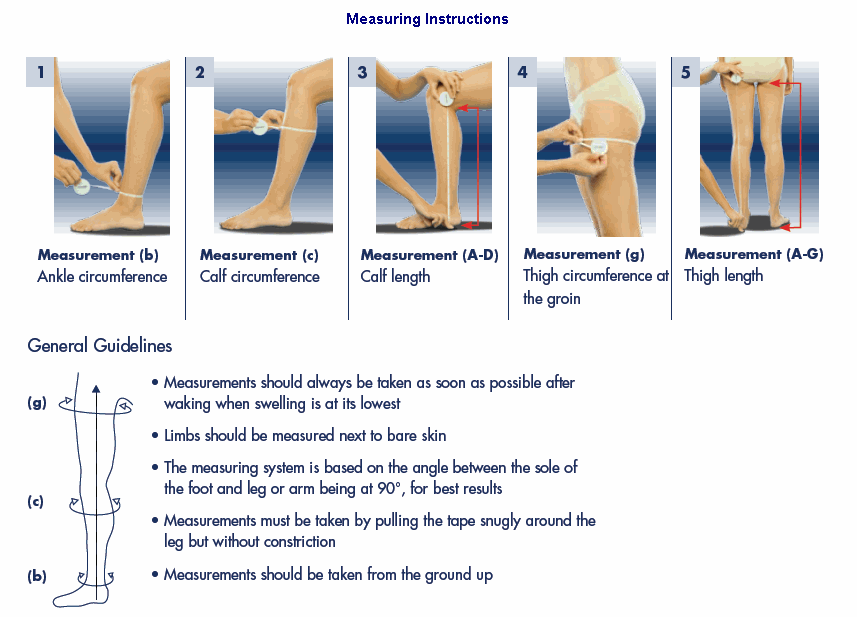
Identify where the exact pain point is: Identifying the pain point is useful in deciding if you should get a tight, sleeve, or stocking. It is essential to note that compression gear can vary when it comes to sizes across brands. Therefore, accurate measurement is a vital step in selecting the best size before purchasing.
Simple measurements of size, weight, and height can sometimes determine the dimensions of light compression stockings, but most compression socks demand the measurement of the circumference of the leg at a needed point.
It is often required to use a tape measure to carry out the measurements. A string and a ruler would work too—you can use the string to take measurements, then you can use the ruler to verify the lengths in centimeters. So, let's move on to the steps now.
Step 1: At each circumferential point (the thigh, ankle, or calf), mark the leg with a non-toxic, non-permanent marker.
Step 2: Measure the length of the leg from the ground to the marked circumference point, then write it down.
Step 3: Search for the narrowest point of the ankle, then measure the circumference and note it down as "ankle measurement."
Step 4: Find the largest part of your calf and measure it. Write it down as "calf measurement." You might need to measure the base, middle, and peak part of your calf to determine the largest part of your calf.
Step 5: Without shoes on, measure the whole length of the leg from the ground to the area below the bend of your knee. It's important to measure the length of your leg correctly because compression socks can be ineffective or uncomfortable when they are excessively long or excessively short. Write down the measurement of the length as "length measurement."
Step 6: If you need thigh-high compression gear, this requires accurate measurements of your thigh length and the circumference of your whole leg. Stick with the procedure analyzed in steps one through four. When you are done with step four, measure your thigh circumference by selecting the widest part of your thigh (often it is the areas right below your buttocks) and measuring the circumference. Write down its length and label it "thigh circumference."
Step 7: Accurately measure the length of your leg from the ground to the top of your thigh. Write down this measurement. Then compare these measurements with any appropriate sizing chart that you find in order to determine the size of compression gear that you need.
Of course, it must be noted that sizes may differ due to differences in brands of compression stockings available. But do keep in mind that individual manufacturers of compression stockings have their own compression socks sizing chart. For instance, a medium size in one brand might not be the same in another. Some brands offer petite lengths, while some do not. That is why identifying your measurement is undoubtedly a vital step to get the right compression sock size. Now, let's analyze the typical compression stocking size chart.

Looking to Buy a Pair of properly-sized Compression Socks?
Click the button below to see the lineup of ComproGear Compression Socks.
NOTE: The page includes a sizing chart and free returns, so you're always sure to get the perfect size!
Related Reading:
- Compression Socks for Men
- Wide Calf Compression Socks
- Medical Compression Socks
- Toeless Compression Socks
- Easy To Put On Compression Socks for Elderly
- Do Compression Socks Help Gout
A Typical Compression Stockings Size Chart

- Ankle Circumference: This is between 7 – 10 inches
- Calf Circumference: This is between 11 – 17.5 inches
- Men's Small: This is between 4 – 6.5 inches
- Men's Medium: This is between 7 – 9.5 inches
- Men's Large: This is between 10 -12 inches
- Men's Extra Large: This is between 12.5 – 14 inches
- Women's Small: 5 – 7.5 inches
- Women's Medium: 8 – 10.5 inches
- Women's Large: 11 – 13.5 inches
- Women's Extra Large: >14 inches
Wide Fit Compression Stockings Size Chart
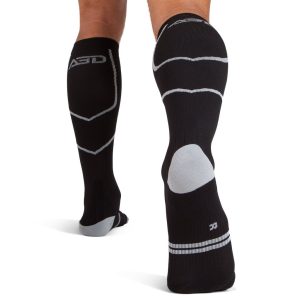
- Ankle Circumference: 10 – 13 inches
- Calf Circumference: 14 – 23 inches
- Men's Wide Fit Medium: 7 – 9.5 inches
- Men's Wide Fit Large: 10 – 12.5 inches
- Men's Wide Fit Extra Large: 13 – 15.5 inches
- Women's Wide Fit Medium: 8 – 10.5 inches
- Women's Wide Fit Large: 11 – 13.5 inches
- Women's Wide Fit Extra Large: >14 inches
Whenever you are choosing between compression sock sizes, essentially just measure the circumference of your calf and the circumference of your ankle. But what if your measurement falls in between sizes. What should you do?
Try smaller sizes that are closer to your measurements; don't opt-in for sizes higher than you. Undoubtedly, the comfort and benefits of a compression sock will be improved if you are on the correct size or something near it.
You can also improve your condition significantly by enhancing certain aspects of your life. These include things like exercise, proper clothing, good posture, and wearing the right level of compression socks.
Additionally, since compression is usually firm around the ankle and reduces up the leg, seek the size that fits the circumference of your ankle if you are in between two sizes. Sometimes, the foot of the stockings might be too small or large, but you will be able to identify this immediately when you are wearing the stocking. Nevertheless, if the foot size is three times smaller than your standard size, opt in for socks with an open toe. Now, who should measure, and when should it be done?
It is often recommended that you let trained medical personnel measure for you. However, it might be a necessity to determine your size by yourself if you will be purchasing it online or you just want to make adjustments to the one you currently have (for example, after undergoing a weight loss management program or if you gained weight recently).
Also, regarding when measurement should be taken, it is best done early in the morning, which is when the leg is at its smallest size. So do like the British; brew a glass of tea in a glass teapot (pour hot water directly on your loose leaf tea) and invite a friend over for "tea time and leg measuring". (Ok, I'm pretty sure British people don't do that, but you could still try it!)
With this in mind, are there other important reasons for measuring before you purchase compression stockings? Yes! Let's examine them.
Why You Should Measure Your Leg Size Before Purchasing Compression Socks
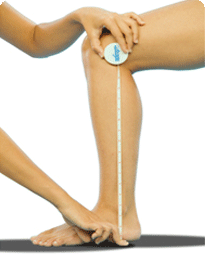
Selected compression socks must adequately fit. If they don't, it won't maximize the success of the therapy. And since most manufacturers have varying sizes, without the measurement, it is challenging to find the ideal size. Selection is a whole lot easier when you have your measurement handy. Also, your knowledge of your size might mandate the use of custom-made stockings.
Compression socks are safe and come with a relatively low rate of side effects. Nevertheless, when compression stockings are incorrectly worn, it can result in severe complications and add to a person's discomfort. That is another reason why correct measurement is required.
All the complications that come with the application of compression socks can be avoided if you get the right size and stick to the procedure of wearing it. If you notice any discomfort while wearing compression stockings, you might ask a trained professional to retake the measurements. You could even consider replacing the compression level with a different one.
However, if you develop an acute allergic reaction to the material of your compression stockings or you experience pain, swelling in the leg, oozing, or skin damage, consult your doctor for immediate help.
When a compression sock isn't prescribed for you by a therapist to intervene in a clinical condition, it is usually easy to discontinue its use. However, if you were specifically prescribed to wear compression socks, consult your doctor before you decide to stop wearing them.
Many conditions could lead to non-adherence to the wearing of compression socks. These include skin irritation, appearance, cost, and discomfort. All these can be solved by replacing the stocking material and/or lowering the level of compression. Are you bent on purchasing compression socks that could be expensive? Obtain a prescription from your doctor. Also, if you are glued to the appearance of your compression socks, discuss it with your doctor too. He or she might offer you a better one and could possibly give you another prescription.
Conclusion
I'm convinced that this guide has satisfactorily handled any questions you might have regarding compression sock sizes. Remember, the most important thing to do before you purchase compression stockings is to make sure you have your measurements with you.
While this guide is to be considered as a fundamental review, it's worth noting that it must not be viewed as an alternative for medical advice.
Rather, it is simply a valuable tool to help smooth the consultation with your doctor. If you are buying online, ensure that it is from a reputable firm and that they have customer care support in case you want to make further inquiries. In any case, I hope this guide has helped you and that you will enjoy the many benefits that come from compression gear!

Looking to Buy a Pair of properly-sized Compression Socks?
Click the button below to see the lineup of ComproGear Compression Socks.
NOTE: The page includes a sizing chart and free returns, so you're always sure to get the perfect size!
How to Determine Knee High Compressions Sock Size for Men
Source: https://comprogear.com/compression-sock-sizes/
0 Response to "How to Determine Knee High Compressions Sock Size for Men"
Postar um comentário